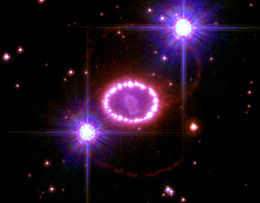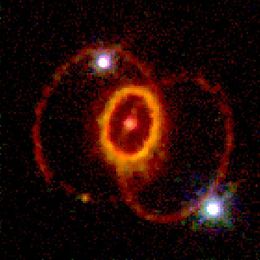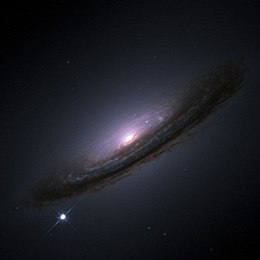Supernova
![]()
The title of this article is ambiguous. For other meanings, see Supernova (disambiguation).
A supernova (from Latin stella nova, super 'new star, beyond'; plural supernovae) is the brief, bright illumination of a massive star at the end of its lifetime by an explosion in which the original star itself is destroyed. The luminosity of the star increases millions to billions of times, and for a short time it becomes as bright as an entire galaxy.
In the process, about one Foe of observable energy is released within seconds. This corresponds to a value of ≈ 3 - 1028 TWh (terawatt hours). For comparison, if the Sun had its current luminosity throughout its lifetime, it would release 3.827 - 1026 W × 3.1536 - 107 s/year × 1010 years ≈ 1.2 foe of energy.
Two basic mechanisms are known by which stars can go supernova:
- Massive stars with an initial mass (see star formation) of more than about eight solar masses, whose core collapses at the end of their evolution and after consumption of their nuclear fuel. This can produce a compact object, such as a neutron star (pulsar) or a black hole. This process is called a collapse or hydrodynamic supernova.
- Lower-mass stars that, in their preliminary final stage as white dwarfs, accrete material (e.g. from a companion in a binary system), collapse by self-gravity, and are torn apart by incipient carbon burning. This phenomenon is called a thermonuclear supernova or a type Ia supernova.
Well-known supernovae are supernova 1987A in the Large Magellanic Cloud and Kepler's supernova (1604). Especially the latter and Tycho Brahe's supernova (1572) have inspired astronomy, as they finally disproved the classical view of the immutability of the fixed star sphere. The most famous supernova remnant is the Crab Nebula (Supernova 1054) in the constellation of Taurus.

Supernova 1987A (HST 2007)

The remnant of Supernova 1987A (March 2005)

Supernova 1994D in the galaxy NGC 4526 (bright point lower left)
History
The term nova derives from the name coined by Tycho Brahe for an observation of a star in 1572, referring to the sudden appearance in the firmament of a previously invisible star-like object. Until the mid-20th century, a nova was understood to be any type of burst of brightness of a star with a rise to maximum in a period of days to years and a return to previous brightness within weeks to decades (see light curve). When the astrophysical cause of the eruptions was recognized, the term changed to today's definition, where a supernova is no longer counted as a novae in its original meaning.
At the beginning of the 20th century, there was still no explanation for the appearance of new or temporary stars, as supernovae were then called. There were several hypotheses, including one by Hugo von Seeliger, according to which the entry of a solid body into a cosmic cloud of finely dispersed matter (with which one imagined space to be filled) leads to a strong heating of the surface of this body and thus to a lighting up. The observed shifts in the spectrum of the new stars were interpreted as an indication that the formation of their dense envelope must have proceeded in a few days.
Naming
Supernovae are named with the prefix "SN", their year of discovery, and an alphabetical suffix. Originally, this suffix consisted of a capital letter assigned alphabetically in the order of discovery. Thus SN 1987A was the first supernova discovered in 1987. 1954 was the first time (in distant galaxies) that more than 26 supernovae were discovered in one year. Since then, small double letters (from "aa" to "zz") have been assigned starting with the 27th supernova in a year. With modern large telescopes and special search programs several hundred supernovae were discovered per year in the 2000s: In 2005 there were 367 (until SN 2005nc), in 2006 there were 551 (until SN 2006ue), and in 2007 even 572 (until SN2007uz). Today there are far more than a thousand per year.
Questions and Answers
Q: What is a supernova?
A: A supernova is the explosion of a giant star that occurs when its nuclear fusion cannot hold the core against its own gravity, causing it to collapse and explode.
Q: What type of stars make supernovae?
A: The biggest stars that make supernovae are hypergiants and smaller ones are supergiants.
Q: How much energy do supernovas emit?
A: Supernovas emit energy equal to that of the whole lifetime of a solar-like star. They also radiate total energy briefly outshining the entire output of a galaxy.
Q: How fast does material from the star travel during an explosion?
A: During an explosion, material from the star travels at velocities up to 30,000 km/s or 10% of the speed of light.
Q: What happens after exploding?
A: After exploding, what is left becomes either a black hole or a neutron star.
Q: Do most stars explode as supernovas?
A: No, most stars are small and do not explode as supernovas. After their red giant phase they become colder and smaller and become white dwarf stars instead.
Q: When was the last time people saw a supernova in our own galaxy, the Milky Way?
A: The last time people saw a supernova in our own galaxy, the Milky Way was in 1604.
Search within the encyclopedia